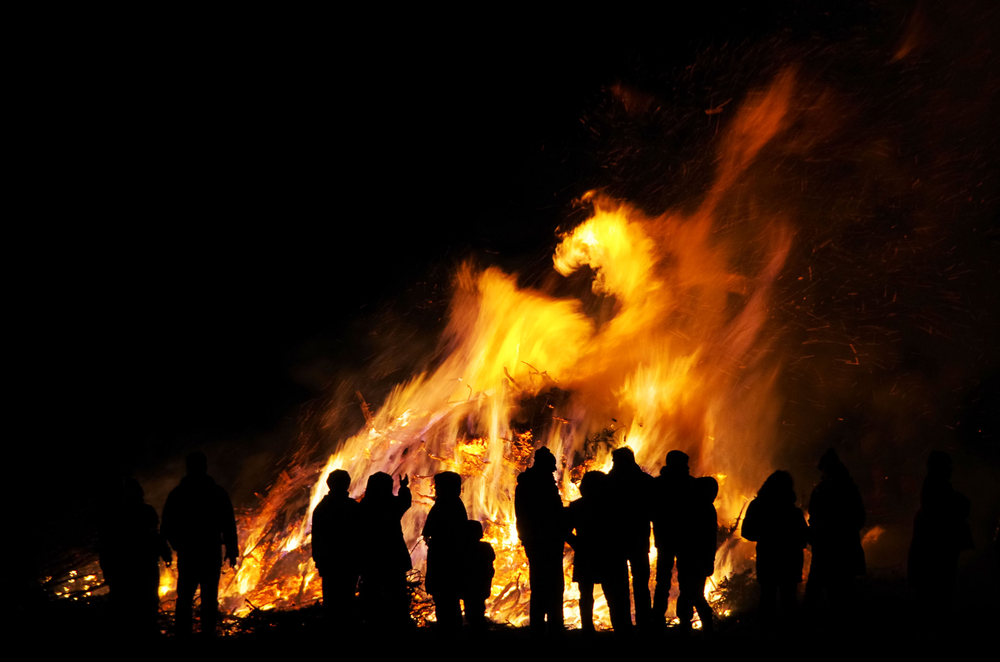Click here to download PDF

The crime and the Penalty
In this week’s Parsha, we have the sad story of the spies that slandered the land of Israel. Chazal tell us that this laid the precedent for Tisha b’Av being a day when calamities happen, most particularly the destructions of the two Temples. Hashem says: “you cried for nothing! I will set for you crying for generations to come“. The punishment seems way out of proportion to the crime. We were deceived by the fake news of the spies; we didn’t know better, so why should we have to pay a real generation-spanning price for a false narrative?
“Ayin” & “Peh”
The book of “Eichah”- Lamentations was written by Yirmiyahu HaNavi to mourn the destruction of the first Beis HaMikdash and it prophetically alludes to the destruction of the second Beis HaMikdash as well. Nearly the whole book alludes to what caused the whole thing in the first place: the sin of the spies. The book-spanning allusion to the sin of the spies is that all chapters, with the exception of the last one, are all set up in the order of the Hebrew alphabet with the first verse or stanza starting with “Aleph” the second verse or stanza with “Beis” and so on. The first chapter follows that pattern perfectly. The chapters in the middle are mostly in the order of the “Aleph – Beis” with the exception that the letters “Ayin” and “Peh” are in reverse order where a verse or stanza will start with “Peh” and will be followed by a verse or stanza starting with “Ayin”. Chazal comment on this and said this is an allusion to the spies that created the whole problem by putting “Peh” – the mouth before “Ayin” – eyes because “they said with their mouths not what they did not see with their eyes”. Two questions immediately arise: If they truly said with their mouths what they didn’t see with their eyes, then verses beginning with “Ayin” (=Eye) should be totally absent similar to how a verse beginning with “Nun” is absent from “Ashrei”. Why are verses beginning with “Ayin” (=eye) following the verses starting with “peh” (=mouth) alluding to the mouth. Why is the first chapter of which also is written in the order of the “Aleph – Beis” fully in the proper order? What happened to the sin of the spies that reversed the “Ayin” and “Peh”? The Maharal addresses the issue and says something very cryptic: “it is to teach you what the proper order is.” This is impossible to take literally. The book of “Eichah” is not nearly as ancient as the Chumash or many other scriptures that were also written in Hebrew. “Eichah” cannot be the primary source for the proper order of the “Aleph – Beis” as Hebrew was used in Speech and in writing for many generations before Yirmiyahu. What does it mean “it is to teach you that this is to be the proper order”? What did the Maharal mean by that?
The Footage was Real
Did they really “say with their mouths what their eyes did not see”? They said, “…the nation that dwells there is powerful, and the cities are fortified and great and also the offspring of the giants we saw there. Amalek dwells in the south and the Chiti and the Yivusi and the Emori dwell on the mountain and the C’naanim dwell by the sea”. Compare that with how Moshe himself describes the land forty years later to the generation that will go into the land of Israel in Parshas Eikev: “Listen Israel. You are crossing the Yarden to come and take over nations that are greater and mightier than you; cities that are great and fortified up to the sky; a big and lofty nation, the children of giants that you know and you heard that no one can stand before the children of the giants”. Even when the spies increased the slander of the land of Israel and added “it is a land that consumes its inhabitants” Rashi says, that that is entirely factual. They saw people constantly burying their dead. In what way did “their mouths say what they did not see with their eyes”?
Speech or Sight?
Before we unravel these difficulties, there is an interesting philosophical question to be raised. Which comes first – sight or speech? One would think that first you observe and then you talk about what has been observed and this is further confirmed from the order of the “Aleph-Beis”, that the letter ‘Ayin’ that means eye, comes before the letter ‘Peh’ that means mouth. However, this is not the case when it comes to Hashem Himself by the creation of the world. He first said, “Let there be light” and afterwards “then there was light” and then “He saw the light that it was good”. The idea and the words that articulate the idea preceded the actual visible creation of the entity and this is true regarding the reality of sight. There was just darkness everywhere, and then Hashem said, ‘Let there be light’, which is the ability to see and only then, was there light and subsequently visibility is possible. What can we learn from this?
First Newscaster – first Fake News
The first news commentator was the snake. Chava had explained to the snake that they are allowed to eat from all the trees in the garden of Eden, with the exception of the “Etz HaDaas”, which Adam had identified for her. The snake gives his narrative that Hashem is barring them from the “Etz HaDaas” to stop them from gaining knowledge and power. After Chava listens to the narrative that the snake presented, it says as follows: “And the woman saw that the tree was good for consumption and it is enticing to the eyes and it was desirable to attain awareness and she took from its fruit and she ate and she gave to her husband who ate with her”. The obvious question is that she had seen the tree before, as Adam pointed it out to her and told her that it is forbidden to eat from. Why does the tree all of a sudden look totally different? Rashi was clearly bothered by this and says on the words “and the woman saw”: she saw the words of the snake and they made sense to her and she believed him. We are being taught a frightening lesson: when you accept a narrative, you can not help but to actually start seeing that way. With this we can understand a seemingly counter-intuitive halacha in the laws of Lashon Hara. The one who listens and believes the Lashon Hara is considered to be a greater sinner than the one who concocted the negative narrative in the first place. One would have thought that the one who concocted the negative narrative and who is slandering is worse than the one who is being ‘suckered’ into accepting the story. This is not the case. The one who is lying knows that he’s lying. The one who ‘buys in’ and believes it turns the lie into his own personal reality and he will always see the slandered literally in the negative light that was presented to him and that person’s life is ruined vis-à-vis the one who accepted the Lashon Hara. If many people buy into the story, that person’s life is really over because those who are willing to believe Lashon Hara make it as real as anything else that they can see.
Lashon Hara
Where does this power come from? It comes from man’s Divine image, as Onkelos translates when Hashem blew in a breath of life into Adam, “he became a speaking spirit”. We get the power of speech from the Divinity within us and if Hashem can create with words, so can we. Fake words create a fake reality which will be real to anybody who believes it. With this the Maharal explains the severity of Lashon Hara. If anyone is ‘in essence bad’, it is he who speaks Lashon Hara, even more than one who commits the cardinal sins. Lashon Hara is to misuse the very Divine essence of a person to destroy Hashem’s reality and supplant it with a fake one.
It’s all in the spin
As is well known, the difference between Lashon Hara and Motzi Shem Ra is that Lashon HaRa has certain elements of factual information, whereas Motzi Shem Ra is a total fabrication. People ask how the Torah could legislate against Lashon HaRa if it is the truth. The answer is best expressed by a sharp statement I heard from HaGaon HaRav Yochanan Zweig, Shlit”a the Rosh Yeshiva of Miami who said, “in Lashon HaRa you use truth to distort reality”. What is evil about Lashon Hara is not the raw facts but rather the spin that is placed on those facts. The narrative and editorial that is superimposed on the facts is the evil of Lashon Hara and having backed it up with a fact or two, can make that evil narrative even more convincing. Therein lies the difference between the way the spies describe Israel, as opposed to how Moshe did so forty years later. They used the same raw facts but the narrative that the spies spun around those facts was one of ‘it is hopeless, it is suicide to conquer the land of Israel’. Moshe’s spin on those very same facts is “you should know today that Hashem your Lord; He will cross into Israel before you. He is a consuming fire. He will destroy them, and He will subjugate them before you. He will chase them out before you and you will quickly obliterate them like Hashem has said”.
With this we can understand how the crying for nothing does indeed warrant something real to cry about. Having accepted the false narrative of the spies as truth, makes it visible reality for those who accept and believe that narrative. You must face the reality you created for yourself. With this we can understand why the ‘Ayin’ does indeed appear in ‘Eichah’ following the ‘Peh’. Once the Jewish people believed in what the spies were telling them, it became reality as they saw it.
Physical & Spiritual – What & Why
The challenge that faced the spies was one that would lead to Lashon Hara more than any other failure. The coming to the land of Israel represents the Jewish people coming to the physical realm as we know it. The physical realm and the laws of nature that govern it are visible, however, what remains invisible is “why” and “for what purpose”. That is all in the realm of explanation. There are many physical phenomena that are clearly visible, but scientists may differ radically in how they explain those phenomena. Case in point: The spies saw many people dropping dead and being buried. They attributed it to the land being a hazardous place to live, when the truth was that Hashem was doing it for the purpose of people being preoccupied with their dead and not taking notice of the strangers in their midst. That is the essence of the challenge of entering the land of Israel. It is to enter the visible physical realm full of hard facts but with all the causality totally hidden from the eye, along with other concepts that are invisible to the eye like morals and values that just perceived in the mind. The Jewish people are to bring the ideas of the Torah and the Torah-perspective of life and superimpose that upon the visible facts of the land of Israel. If that unification is successful, it results in the open revelation of all the truths of the Torah within the physical inside the borders of the Holy land that has the special quality of displaying the spiritual, which merged with it. This is the secret behind the miracles we see in the land of Israel such as the triple crop that grows before Shmittah; how no one invades the land when all the Jewish people ascend to Yerushalayim during the three Regalim; the revealed presence of the Shechinah in the Beis HaMikdash with all the miracles that occurred there on a regular basis and most amazingly, the extra space that opens up when the Jews bow in the Beis HaMikdash or the miraculous expanse of the city of Tur Malka recorded in the Gemara in Gittin which mysteriously disappeared when we were exiled from the land. This is the unique challenge in the conquest of Eretz Yisroel. It is not just to liberate the land from the seven nations but is also to connect the land to the spiritual which will have a spill-over effect on the whole world. The land of Israel is the only place on the globe capable of being grafted to the spiritual to the point that the spiritual becomes visible within the land. The spies failed to make that connection.
The Desert vs The Land of Israel
Contrast that with the generation of the desert under Moshe’s leadership where the situation was the polar opposite. The only thing the Jews saw around them was the supernatural; the clouds of glory, the miraculous well; the Manna from heaven; all the miracles that Moshe did for them and the experience of getting Torah directly from Moshe was as if getting it directly from Hashem as ‘the Divine presence speaks through his mouth’(). For the Jews in the desert, the spiritual was the visible and they did not know how to cope with the physical that obscures the spiritual. This is how the Nefesh HaChaim explains what it says by the giving of the Torah, ‘all the nations saw the sounds’. The sounds which represent the ideas that are in the mind were visible, whereas the things that we would call visible in our day and age, were distant- abstract concepts to them. The spies couldn’t cope the spiritual being invisible to the eye within the physical realm and thus attributed the wrong explanation to what they saw. That false narrative is ‘Lashon Hara’.
Our Creativity
Hashem who creates everything from the conceptual level down to the physical level – in that order. For Hashem the word, which is the concept, which for us would be carried by speech, comes before the visible emergence of that object. Therefore, for Hashem it is first to say, ‘let there be light’ and only then, light comes into existence and it is possible after that to say, ‘and he saw that it was good’. This is not the case for us. Although man is also to be a creator and to create with his speech like Hashem does, we don’t invent ideas out of nowhere, but rather we create by explaining them. In other words, our room for creativity is in the enhancement of the concepts that Hashem created. As we have said in the past, our room to create with our mouths is in the Oral Torah which is to put explanation upon the axioms that were revealed to us in the written Torah or the Halacha l’Moshe M’sinai, which is like a Pasuk, just not in writing. We are granted creativity in the explanation of those axioms, but we can never deviate from them in any way. Someone who deviates from these axioms is not creative, he is simply dead wrong. The written Torah which is the visible Torah absorbed with the eyes, and anything passed down by Mesorah which has the equivalent status, are plain facts that must be accepted, and our role is to interpret and explain them. That is to go from “Ayin” the written Torah visible to the eye, to “Peh” the mouth that carries the oral Torah that explains the written Torah.
Bavli vs Yerushalmi
The relationship between the written Torah and the oral Torah that we superimpose upon it is a parallel relationship to the Jewish people with their Torah perspective acquired in the desert and Eretz Yisroel which is where those ideas have to be imprinted upon. If we are successful, the ideas and values of the Torah actually become visible within the land of Israel. Whereas, outside of the land of Israel the truths of the Torah remain forever hidden from the naked eye and remain a matter of faith. With this we can understand that even though we are talking about the Oral Torah, we also called it ‘the light of the Menorah’, the oral Torah only attains that level of clarity to the point that it can be seen in the land of Israel. And that is the secret that prophecy, which is visual, is only either in Israel or for the sake of the land of Israel and the Zohar and Yerushalmi that were written in Israel, when coming to make a point say ‘Ta chazi’ – ‘come and see’. Part of the penalty of the exile is that we get thrust into the polar opposite situation and Hashem “puts us in darkness like those dead to the world” Which the Gemara in Sanhedrin calls ‘Talmud Bavli’. The dialectical method of the Talmud Bavli is a countermeasure to our recognition that we are blind to even the simplest truth and that’s why every idea has to be challenged and tested from every angle before it can be accepted as truth and that is why the Talmud Bavli when making appoint says, ‘Ta Shma’ – come and hear, because we are simply blind.
Getting Back
With this we can understand what the Maharal meant to say, that the first chapter in “Eichah” is written in the proper order of ‘Ayin’ before ‘Peh’, to teach you that this is the proper order. The Maharal did not mean to say that “Eichah” is the source for the order of the “Aleph-Beis” but rather, it is a reminder as to the shift that has occurred as a result of being exiled from the land of Israel: that we were plunged into total darkness. We used to see certain basic truths and yearned to describe and explain them in a manner that is faithful to the truths, those visible facts meant to reveal and instead, we’re in a world of everyone setting a narrative to be sold as facts. We are reminded of what we have to yearn for: to get back to the level that there was at Sinai which is the level that we will regain in the future; “all flesh will see together that the mouth of Hashem has spoken”, and as we say in the Kedushas of Shabbos – “May our eyes see your Kingdom” “May Hashem let us hear to the eyes of all living creatures, I will be your master” speedily in our days, Amein.










